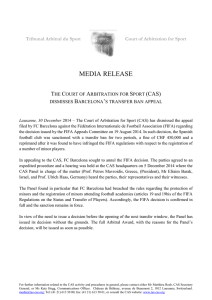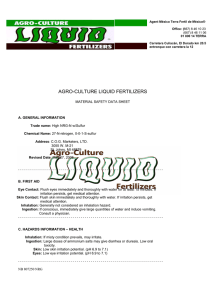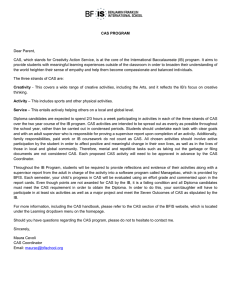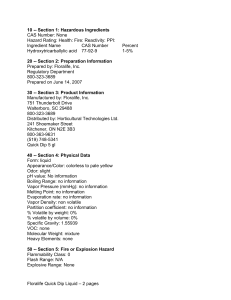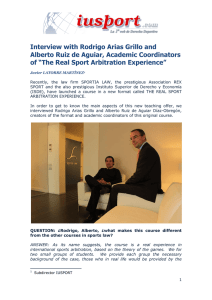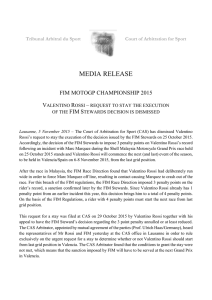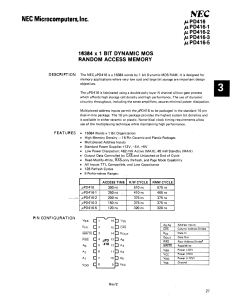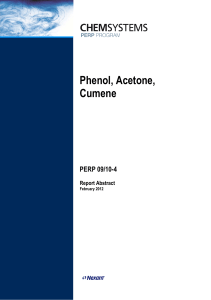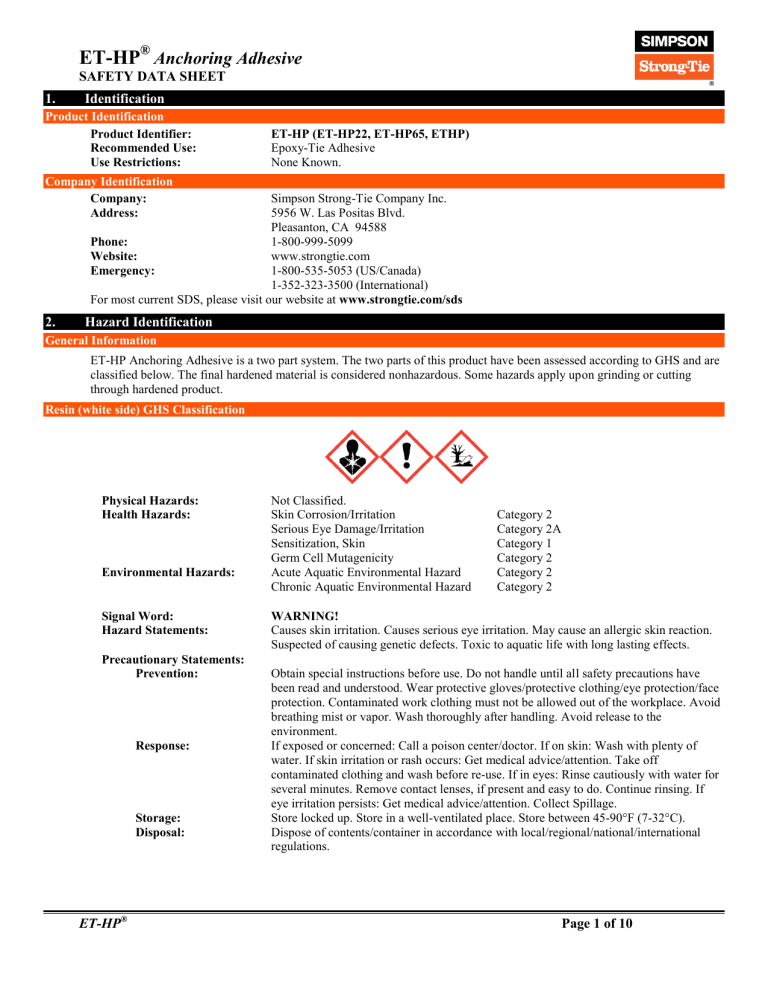
ET-HP® Anchoring Adhesive SAFETY DATA SHEET 1. Identification Product Identification Product Identifier: Recommended Use: Use Restrictions: ET-HP (ET-HP22, ET-HP65, ETHP) Epoxy-Tie Adhesive None Known. Company Identification Company: Address: Simpson Strong-Tie Company Inc. 5956 W. Las Positas Blvd. Pleasanton, CA 94588 Phone: 1-800-999-5099 Website: www.strongtie.com Emergency: 1-800-535-5053 (US/Canada) 1-352-323-3500 (International) For most current SDS, please visit our website at www.strongtie.com/sds 2. Hazard Identification General Information ET-HP Anchoring Adhesive is a two part system. The two parts of this product have been assessed according to GHS and are classified below. The final hardened material is considered nonhazardous. Some hazards apply upon grinding or cutting through hardened product. Resin (white side) GHS Classification Physical Hazards: Health Hazards: Environmental Hazards: Signal Word: Hazard Statements: Precautionary Statements: Prevention: Response: Storage: Disposal: ET-HP® Not Classified. Skin Corrosion/Irritation Serious Eye Damage/Irritation Sensitization, Skin Germ Cell Mutagenicity Acute Aquatic Environmental Hazard Chronic Aquatic Environmental Hazard Category 2 Category 2A Category 1 Category 2 Category 2 Category 2 WARNING! Causes skin irritation. Causes serious eye irritation. May cause an allergic skin reaction. Suspected of causing genetic defects. Toxic to aquatic life with long lasting effects. Obtain special instructions before use. Do not handle until all safety precautions have been read and understood. Wear protective gloves/protective clothing/eye protection/face protection. Contaminated work clothing must not be allowed out of the workplace. Avoid breathing mist or vapor. Wash thoroughly after handling. Avoid release to the environment. If exposed or concerned: Call a poison center/doctor. If on skin: Wash with plenty of water. If skin irritation or rash occurs: Get medical advice/attention. Take off contaminated clothing and wash before re-use. If in eyes: Rinse cautiously with water for several minutes. Remove contact lenses, if present and easy to do. Continue rinsing. If eye irritation persists: Get medical advice/attention. Collect Spillage. Store locked up. Store in a well-ventilated place. Store between 45-90°F (7-32°C). Dispose of contents/container in accordance with local/regional/national/international regulations. Page 1 of 10 ET-HP® Anchoring Adhesive SAFETY DATA SHEET Hardener (black side) GHS Classification Physical Hazards: Health Hazards: Environmental Hazards: Signal Word: Hazard Statements: Precautionary Statements: Prevention: Response: Storage: Disposal: Not Classified. Skin Corrosion/Irritation Serious Eye Damage/Irritation Sensitization, Skin Germ Cell Mutagenicity Reproductive Toxicity (Fertility) STOT, Repeated Exposure (kidney, liver, nervous system, skin) Acute Aquatic Environmental Hazard Chronic Aquatic Environmental Hazard Category 2 Category 1 Category 1 Category 1A Category 2 Category 2 Category 2 Category 2 DANGER! Causes skin irritation. Causes serious eye damage. May cause an allergic skin reaction. Suspected of causing genetic defects. Suspected of damaging fertility. May cause damage to organs (kidney, liver, nervous system, skin) through prolonged or repeated exposure. Toxic to aquatic life with long lasting effects. Obtain special instructions before use. Wear protective gloves/protective clothing/eye protection/face protection. Do not handle until all safety precautions have been read and understood. Do not breathe mist or vapor. Wash thoroughly after handling. Contaminated work clothing must not be allowed out of the workplace. Avoid release to the environment. If exposed or concerned: Get medical advice/attention. If on skin (or hair): Take off immediately all contaminated clothing. Rinse skin with water/shower. If skin irritation or rash occurs: Get medical advice/attention. Take off contaminated clothing and wash it before reuse. If in eyes: Rinse cautiously with water for several minutes. Remove contact lenses, if present and easy to do. Continue rinsing. Get medical advice/attention if you feel unwell. Collect Spillage. Store locked up. Store in a well-ventilated place. Store between 45-90°F (7-32°C). Dispose of contents/container in accordance with local/regional/national/international regulations. Hazards Not Otherwise Classified (HNOC) The above hazards are for the uncured components of ET-HP. Upon combination the components of ET-HP form an innocuous solid which does not present any immediate hazards. Upon grinding or cutting the cured product the following hazards may apply. Health Hazards: Hazard Statements: Precautionary Statements: 3. Carcinogenicity Category 1A STOT, repeated exposure Category 2 (Lung) May cause cancer. May cause damage to organs (Lung) through prolonged or repeated exposure. Do not breathe dust. Composition Information General Information This product is a mixture. Hazardous ingredients for each component are listed below. May include other nonhazardous ingredients. May include other trace ingredients, see Section 15. ET-HP® Page 2 of 10 ET-HP® Anchoring Adhesive SAFETY DATA SHEET Resin (white side) Chemical Name Bisphenol A/Epichlorohydrin Phenol, polymer with formaldehyde, glycidyl ether Butyl Glycidyl Ether Titanium Dioxide CAS Number 25068-38-6 28064-14-4 2426-08-6 13463-67-1 Weight % 40-60 20-30 1-10 1-10 CAS Number 140-31-8 80-05-7 90-72-2 84852-15-3 108-95-2 14808-60-7 69009-90-1 1477-55-0 Weight % 5-15 5-10 1-10 1-10 1-10 5-10 1-10 1-10 Hardener (black side) Chemical Name 2-Piperazin-1-ylethylamine 4,4,'-isopropylidenediphenol 2,4,6-Tris-(dimethylaminomethyl)-phenol Nonylphenol Phenol Crystalline Silica, Quartz diisopropyl-1,1'-biphenyl m-Phenylenebis(methylamine) 4. First-Aid Measures General Information Provide general supportive measures and treat symptomatically. Symptoms may be delayed. Ensure that medical personnel are aware of the material(s) involved, and take precautions to protect themselves. If exposed or concerned: Get medical advice/attention. Wash contaminated clothing before reuse. Routes of Exposure Eye Contact: Immediately flush eyes with plenty of cool water for at least 15 minutes while holding the eyes open. Remove contact lenses if present and easy to do. If redness, burning, blurred vision, or swelling persists, consult a physician. Skin Contact: Remove contaminated clothing and product; wash affected area with soap and water. Do not apply greases or ointments. If skin irritation persists consult a physician. Ingestion: Rinse mouth immediately. Give large amounts of milk or water, if person is conscious. Only induce vomiting at the instruction of medical personnel. Consult a physician. Inhalation: Remove patient to fresh air. Give oxygen or artificial respiration if needed. If patient continues to experience difficulty breathing, consult a physician. Most Important Symptoms Irritant effects. May cause severe irritation or burns to the eyes, skin, gastrointestinal tract, and respiratory system. Symptoms may include stinging, tearing, redness, swelling, and blurred vision. May cause allergic skin reaction. Rash. 5. Fire-Fighting Measures Suitable Extinguishing Media: Additional Information: Hazards during Fire-Fighting: Fire-Fighting Procedures: 6. Extinguish with foam, carbon dioxide, dry powder, or water fog. Do not use water jet as an extinguisher as this will spread the fire. Hazardous decomposition products may occur when materials polymerize at temperatures above 500° F (260°C). Irritating and toxic gases/fumes may be released during a fire. Do not allow run-off from fire-fighting to enter drains or water courses. Use standard firefighting procedures and consider the hazards of other involved materials. In case of fire and/or explosion do not breathe fumes. Self-contained breathing apparatus and full protective clothing must be worn. Move containers from fire area if you can do so without risk. Cool containers with flooding quantities of water until well after fire is out. Prevent runoff from fire control or dilution from entering streams, sewers, or drinking water supply. Accidental Release Measures Personal Precautions Keep unnecessary personnel away. Eliminate all ignition sources (no smoking, flares, sparks, or flames in immediate area). Wear appropriate personal protective equipment. Do not touch damaged containers or spilled material unless wearing ET-HP® Page 3 of 10 ET-HP® Anchoring Adhesive SAFETY DATA SHEET appropriate protective clothing. Avoid inhalation of vapors or mists. Ensure adequate ventilation. Local authorities should be advised if significant spillages cannot be contained. Clean-Up Methods Small spills: Wipe up with absorbent material (e.g. cloth, fleece). Place in leak-proof containers. Seal tightly for proper disposal. Clean surface thoroughly. Large spills: Stop the flow of material, if this is without risk. Dike far ahead of spill for later disposal. Use a non-combustible material like vermiculite, sand or earth to soak up the product. Place in leak-proof containers. Seal tightly for proper disposal. Following product recovery, flush area with water. Prevent entry into waterways, sewer, basements or confined areas. Environmental Precautions Avoid release to the environment. Contact local authorities in case of spillage to drain/aquatic environment. Prevent further leakage or spillage if safe to do so. 7. Handling and Storage Handling Keep away from open flames, hot surfaces and sources of ignition. Wear appropriate personal protective equipment. When using, do not eat, drink or smoke. Avoid contact with eyes, skin, and clothing. Pregnant women should not work with this product if there is risk of exposure. Observe good industrial hygiene practices. Storage Store in a closed container away from incompatible materials. Keep in original container. Keep container tightly closed. Store in a dry place out of direct sunlight. Keep out of the reach of children. Store between 45-90°F (7-32°C). Keep away from heat and sources of ignition. Store in a well-ventilated place. Store locked up. 8. Exposure Controls / Personal Protection Personal Protective Equipment Protective Measure: Eye Protection: Hand Protection: Skin and Body Protection: Respirator Protection: General Hygiene: Wear appropriate personal protective equipment. Wear chemical splash goggles or safety glasses with side shield. Wear chemical-resistant gloves such as: Nitrile, neoprene, butyl. Wear long sleeve shirts/long pants and other clothing as required to minimize contact. The use of a respirator is not required during regular use of this product. If cutting or grinding cured product the use of an approved respirator is recommended. Always observe good personal hygiene measures, such as washing after handling the material and before eating, drinking, and/or smoking. Routinely wash work clothing and protective equipment to remove contaminants. Engineering Controls When using indoors good general ventilation (typically 10 air changes per hour) should be used. Ventilation rates should be matched to conditions. Ready access to running water is required. Provide eyewash station. Exposure Limits Component N-Butyl Glycidyl Ether (2426-08-6) Titanium Dioxide (13463-67-7) Phenol* (CAS 108-95-2) Quartz (14808-60-7) m-Phenylenebis(methylamine)* (CAS 1477-55-0) OSHA (PEL) 270 mg/m3 50 ppm ACGIH (TLV) 3 ppm NIOSH Pocket Guide 30 mg/m3 (Ceiling) 5.6 ppm (Ceiling) 5 mg/m3(respirable) 15 mg/m3(total dust) 10 mg/m3 N/E 19 mg/m3 5 ppm 5 ppm 60 mg/m3 (Ceiling) 15.6 ppm (Ceiling) 0.3 mg/m3(total dust) 0.1 mg/m3 (respirable) 0.025 mg/m3 (respirable) 0.05 mg/m3 (respirable) N/E 0.1 mg/m3 (Ceiling) 0.1 mg/m3 (Ceiling) *Skin Designation: Material can be absorbed through the skin. ET-HP® Page 4 of 10 ET-HP® Anchoring Adhesive SAFETY DATA SHEET Additional Information After Cure: 9. Physical and Chemical Properties Property Physical State: Color: Odor: pH: Flammability limit – lower %: Flammability limit – upper %: Vapor Pressure: Vapor Density: Solubility: Freezing/Melting Point: Boiling Point: Flash Point: Evaporation Rate: Decomposition Temperature: Specific Gravity: VOC (after cure): Kow: Viscosity: 10. Resin Liquid, Paste White Sweet 6.9 No data No data Non-volatile No data Insoluble in water No data > 500 °F (>260 °C) 250 °F (121 °C) Open Cup No data No data 1.19 at 72°F (22°C) 3 g/L No data No data Hardener Liquid, Paste Black Ammonia 10.2 No data No data No data No data Slightly soluble in water No data No data 225 °F (107 °C) Open Cup No data No data 1.36 at 72°F (22°C) 3 g/L No data No data Stability and Reactivity Resin (white side) Reactivity: Chemical Stability: Condition to Avoid: Substances to Avoid: Hazardous Reactions: Decomposition Products: Hardener (black side) Reactivity: Chemical Stability: Condition to Avoid: Substances to Avoid: Hazardous Reactions: Decomposition Products: 11. Product forms an innocuous solid. Processing after cure (grinding or cutting) may produce dust containing compounds that present an inhalation hazard. This product is stable and non-reactive under normal conditions. Stable under normal storage conditions. High heat and open flame. Oxidizing agents, acids, organic bases, and amines Hazardous polymerization does not occur. Carbon dioxide, carbon monoxide, oxides of nitrogen, and other organic compounds. This product is stable and non-reactive under normal conditions. Stable under normal storage conditions. High heat and open flame. Strong oxidizing agents. Peroxides. Phenols. Acids. The product is stable if stored and handled as prescribed/indicated. Carbon dioxide, carbon monoxide, oxides of nitrogen, and other organic compounds. Toxicological Information Likely Routes of Exposure Ingestion: Inhalation: Skin contact: Eye contact: Information on Toxicological Effects Acute toxicity: Causes digestive tract burns. Ingestion may cause irritation to the gastrointestinal tract. If this material is heated or misted, coughing and mild, temporary irritation may occur. Inhalation of dust from cutting/grinding cured product may irritate the respiratory tract. Causes skin irritation. Causes severe skin burns. May cause an allergic skin reaction. Causes serious eye irritation. Causes serious eye damage. Occupational exposure to the substance or mixture may cause adverse effects. Product Butyl Glycidyl Ether (2426-08-6) Acute, Dermal, LC50 Acute, Inhalation, LC50 Acute, Oral, LD50 ET-HP® Species Test Result Rabbit Rat Rabbit 2520 µL/kg 1030 ppm, 8 hours 1660 mg/kg Page 5 of 10 ET-HP® Anchoring Adhesive SAFETY DATA SHEET Product Bisphenol A/Epichlorohydrin (25068-38-6) Acute, Dermal, LC50 Acute, Oral, LD50 2-Piperazin-1-ylethylamine (CAS 140-31-8) Acute, Dermal, LD50 4,4,'-isopropylidenediphenol (CAS 80-05-7) Acute, Oral, LD50 Nonylphenol (CAS 84852-15-3) Acute, Dermal, LD50 Acute, Oral, LD50 Phenol (CAS 108-95-2) Acute, Dermal, LD50 Acute, Oral, LD50 m-Phenylenebis(methylamine) (CAS 1477-55-0) Acute, Dermal, LD50 Acute, Inhalation, LC50 Acute, Oral, LD50 Skin corrosion/irritation: Eye damage/eye irritation: Respiratory sensitization: Skin sensitization: Germ cell mutagenicity: Carcinogenicity: Reproductive toxicity: Aspiration hazard: Specific target organ toxicity: Single exposure Repeated exposure Species Test Result Rat Rat >2000 mg/kg >5000 mg/kg Rabbit 880 mg/kg Rat Mouse 3300 mg/kg 2500 mg/kg Rabbit Rat 2140 mg/kg 1600 mg/kg Rabbit Rat 850 mg/kg 317 mg/kg Rabbit Rat Rat 2000 mg/kg 700 ppm, 1 hour 930 mg/kg Causes skin irritation. Causes skin burns. Causes serious eye irritation. Causes serious eye damage. No data available. May cause an allergic skin reaction. Contains a component that is suspected of causing genetic defects. Cured product contains Quartz and Titanium Dioxide, which are considered carcinogens only in their inhalable form. Due to the nature of this product inhalation is highly unlikely. Exposure to respirable Quartz and Titanium Dioxide is likely only when grinding or cutting cured product, ensure good work practice and use of personal protective equipment as needed to control exposure. IARC Monographs. Overall Evaluation of Carcinogenicity Quartz (CAS 14808-60-7) 1 Carcinogenic to humans. Titanium Dioxide (13463-67-7) 2B Possibly Carcinogenic to humans. Phenol (CAS 108-95-2) 3 Not classifiable as to carcinogenicity to humans. NTP Report on Carcinogens Quartz (CAS 14808-60-7) Known To Be Human Carcinogen. Suspected of damaging fertility. No data available. No data available. May cause damage to organs (kidney, Liver, Lung, nervous system, skin) through prolonged or repeated exposure. Further Information Toxicological, ecotoxicological, physical, and chemical properties may not have been fully investigated. Hazard data above is estimated based on best available information. Some workers with pre-existing medical conditions such as: asthma, allergies, or impaired pulmonary and/or liver functions, or who may be particularly susceptible to this material, may be affected by exposure to this material. 12. Ecological Information General Information Information given is based on data on the components and the ecotoxicology of similar products. Product is classified as toxic to aquatic life with long lasting effects. Avoid release to the environment. ET-HP® Page 6 of 10 ET-HP® Anchoring Adhesive SAFETY DATA SHEET Supporting Data Component Species Test Result Bisphenol A/Epichlorohydrin (25068-38-6) Fish, LC50 Salmo Gairdneri 1.5 mg/l, 96 hours Aquatic, Crustacea, EC50 Daphnia Magna 2.7 mg/l, 48 hours Titanium dioxide (CAS 13463-67-7) Aquatic, Crustacea, EC50 Daphnia >1000 mg/l, 48 hours Aquatic, Fish, LC50 Mummichog >1000 mg/l, 96 hours 2-Piperazin-1-ylethylamine (140-31-8) Aquatic, Fish, LC50 Fathead Minnow 1950-2460 mg/l, 96 hours 4,4,'-isopropylidenediphenol (CAS 80-05-7) Aquatic, Fish, LC50 Fathead Minnow 3.6-5.4 mg/l, 96 hours Nonylphenol (CAS 84852-15-3) Aquatic, Crustacea, EC50 Clam 0.0379 mg/l, 48 hours Aquatic, Fish, LC50 Winter Flounder 0.017 mg/l, 96 hours Phenol (CAS 108-95-2) Aquatic, Crustacea, EC50 Daphnia 4.7-6.4 mg/l, 48 hours Aquatic, Fish, LC50 Rainbow Trout 7.7 mg/l, 96 hours Persistence and degradability: No data available. Bioaccumulative potential: No data available for this product. Partition coefficient n-octanol / water (log Kow) Phenol (108-95-2) 1.46 4,4,'-isopropylidenediphenol (80-05-7) 3.32 Nonylphenol (25154-52-3) 5.71 Mobility in soil: No data available. Further Information No other adverse environmental effects (e.g. ozone depletion, photochemical ozone creation potential, endocrine disruption, global warming potential) are expected from this product. 13. Disposal Consideration Waste Disposal of Substance: Container Disposal: Disposal of Cured Product: 14. Do not allow this material to drain into sewers/water supplies. Do not contaminate ponds, waterways or ditches with chemical or used container. Dispose of contents/container in accordance with local/regional/national/international regulations. Empty containers or liners may retain some product residues; follow label warnings even after container is emptied. Empty containers should be taken to an approved waste handling site for recycling or disposal. Chip or grind off surface. Solid material does not need special disposal consideration. Transportation Information Resin (white side) UN number: UN proper shipping name: Precautions: Required Labels: ERG Code (IATA): EmS (IMDG): Hardener (black side) UN number: UN proper shipping name: Precautions: Required Labels: ERG Code (IATA): EmS (IMDG): ET-HP® UN3082 ENVIRONMENTALLY HAZARDOUS SUBSTANCE, LIQUID, N.O.S. (Bisphenol-A-Epichlorohydrin), 9, III, Marine Pollutant Marine Pollutant 9 9L F-A, S-F UN3082 ENVIRONMENTALLY HAZARDOUS SUBSTANCE, LIQUID, N.O.S. (Nonylphenol), 9, III, Marine Pollutant Marine Pollutant 9 9L F-A, S-F Page 7 of 10 ET-HP® Anchoring Adhesive SAFETY DATA SHEET Additional Information Special precautions for user: Read safety instructions, SDS and emergency procedures before handling. Transport in bulk according to Annex II of MARPOL 73/78 and the IBC Code: This substance/mixture is not intended to be transported in bulk This information does not cover all specific regulatory or operational requirements of this product. The classifications for transportation may vary by container volume or different regional or national regulations. 15. Regulatory Information United States Federal Regulations: This product is a "Hazardous Chemical" as defined by the OSHA Hazard Communication Standard, 29 CFR 1910.1200. TSCA Section 12(b) Export Notification (40 CFR 707, Subpt. D) US. OSHA Specifically Regulated Substances (29 CFR 1910.1001-1050) CERCLA Hazardous Substance List (40 CFR 302.4) 4,4,’-isopropylidenediphenol (CAS 80-05-7) LISTED Phenol (CAS 108-95-2) LISTED Superfund Amendments and Reauthorization Act of 1986 (SARA) Hazard Categories: Immediate Delayed Fire Resin Yes Yes No Hardener Yes Yes No SARA 302 Extremely hazardous substance No SARA 311/312 Hazardous chemical Yes SARA 313 (TRI reporting) Chemical Name CAS Number Phenol 108-95-2 4,4,’-isopropylidenediphenol 80-05-7 Not regulated. Not listed. Pressure No No Reactivity No No % by weight 1-10 5-10 US. California Proposition 65 WARNING: This product contains a chemical known to the State of California to cause cancer, birth defects, or reproductive harm. Component Regulation % In Blend (approx.) Remark Quartz (14808-60-7) ACGIH 5-10 Carcinogenic Carbon Black (1333-86-4) ACGIH < 0.1 Carcinogenic Titanium dioxide (13463-67-7) ACGIH 1-10 Carcinogenic US State Right-To-Know Lists Chemical 2-Piperazin-1-ylethylamine (CAS 140-31-8) 4,4,’-isopropylidenediphenol (CAS 80-05-7) m-Phenylenebis(methylamine) (CAS 1477-55-0) Nonylphenol (CAS 84852-15-3) Phenol (CAS 108-95-2) Quartz (CAS 14808-60-7) Butyl Glycidyl Ether (CAS 2426-08-6) Titanium dioxide (CAS 13463-67-7) ET-HP® Massachusetts RTK New Jersey Work and Community RTK Act Pennsylvania Worker and Community RTK Law Listed Listed Listed Listed Listed Listed Listed Listed Listed Listed Listed Listed Listed Listed Listed Listed Listed Listed Listed Rhode Island RTK Listed Listed Page 8 of 10 ET-HP® Anchoring Adhesive SAFETY DATA SHEET Canada This product has been classified according to the hazard criteria of the CPR and the SDS contains all of the information required by the CPR. WHMIS Classification Class E: Corrosive Class D-2A: Material Causing other toxic effects International International Inventories Country or Inventory Region Australia Australian Inventory of Chemical Substances (AICS) Canada Domestic Substances List (DSL) Canada Non-Domestic Substances List (NDSL) China Inventory of Existing Chemical Substances in China (IECSC) Europe European Inventory of Existing Commercial Chemical Substances (EINECS) Europe European List of Notified Chemical Substances (ELINCS) Japan Inventory of Existing and New Chemical Substances (ENCS) Korea Existing Chemicals List (ECL) New Zealand New Zealand Inventory Philippines Philippine Inventory of Chemicals and Chemical Substances (PICCS) United States & Toxic Substances Control Act (TSCA) Inventory Puerto Rico 16. On Inventory? (Yes/No) No Yes No Yes No No No No Yes No Yes Other Information Date Prepared or Revised: Supersedes: September 2014 August 2013 Additional Resin (white side) Classifications NFPA Ratings HMIS Rating 1 HEALTH HAZARD 2 FLAMMABILTY HAZARD 1 PHYSICAL HAZARD 0 PERSONAL PROTECTION B 0 2 Additional Hardener (black side) Classifications NFPA Ratings HMIS Rating 1 2 ET-HP® 0 HEALTH HAZARD 2 FLAMMABILTY HAZARD 1 PHYSICAL HAZARD 0 PERSONAL PROTECTION B Page 9 of 10 ET-HP® Anchoring Adhesive SAFETY DATA SHEET Abbreviations ACGIH: CAS No.: CERCLA: CPR: DOT: EPA: GHS: HEPA: HMIS: IARC: IATA: IMDG: LPP: NIOSH: NFPA: NTP: OSHA: PEL: SARA: SDS: STEL: STOT: TLV: TSCA: TWA: U.S.: VOC: WHMIS: American Conference of Governmental Industrial Hygienists Chemical Abstract Service Registry Number Comprehensive Environmental Response, Compensation and Liability Act (U.S. EPA) Controlled Product Regulations (Canada) Department of Transportation (U.S.) Environmental Protection Agency (U.S.) Globally Harmonized System of Classification and Labeling of Chemicals High-Efficiency Particulate Air Hazardous Materials Identification System International Agency for Research on Cancer International Air Transport Association International Maritime Dangerous Goods code Limité Permisible Ponderado (Chile) National Institute of Occupational Safety and Health (U.S.) National Fire Protection Association (US) National Toxicology Program (US) Occupational Safety and Health Administration (U.S.) Permissible Exposure Limit Superfund Amendments and Reauthorization Act (U.S. EPA) Safety Data Sheet Short Term Exposure Limit (15 minute Time Weighted Average) Specific Target Organ Toxicity (GHS Classification) Threshold Limit Value Toxic Substances Control Act (U.S.) Time Weighted Average (exposure for 8-hour workday) United States Volatile Organic Compounds Canadian Workplace Hazardous Materials Information System Disclaimer This Safety Data Sheet (SDS) is prepared by Simpson Strong-Tie Co. in compliance with the requirements of OSHA 29 CFR Part 1910.1200. The information it contains is offered in good faith as accurate as of the date of this SDS. This SDS is provided solely for the purpose of conveying health, safety, and environmental information. No warranty, expressed or implied, is given. Health and Safety precautions may not be adequate for all individuals and/or situations. It is the user's obligation to evaluate and use this product safely and to comply with all applicable laws and regulations. 2014 Simpson Strong-Tie Company Inc. Internal FOR INTERNAL USE ONLY ET-HP Resin: XCOM3B – 50% Cartridge ET-HP® ET-HP Hardener: XCOM3B – 50% Cartridge Page 10 of 10
